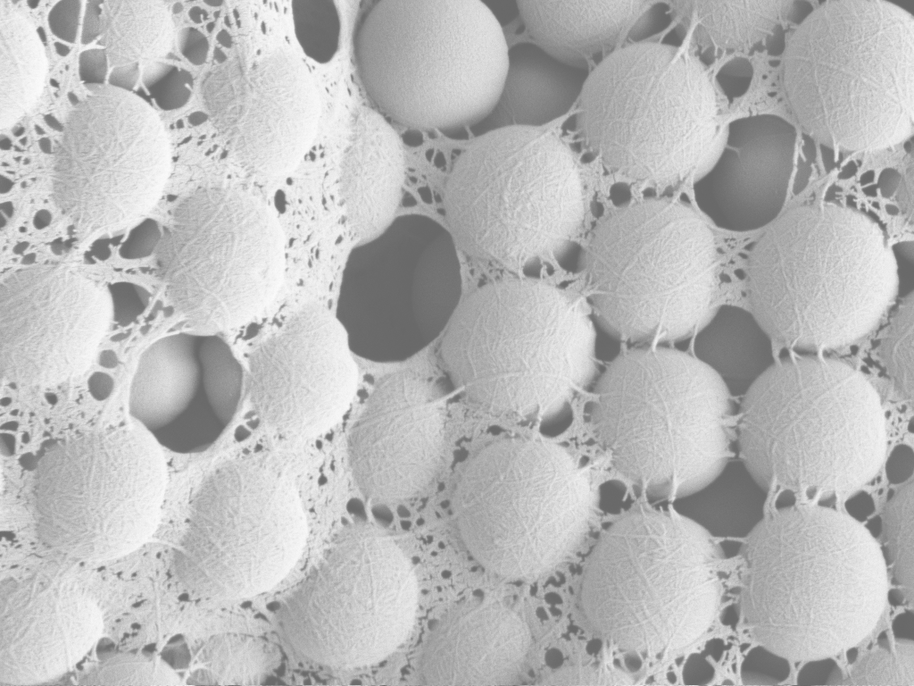May 12 2020
Tiny fibrils derived from plants have gained considerable attention. Such nanomaterials have exhibited great potential in outshining plastics, and even substituting them.
 A scanning electron micrograph shows a fishnet structure formed by nanocellulose that has bound 1.15 μm of silica particles together. Image Credit: Bruno Mattos/Aalto University.
A scanning electron micrograph shows a fishnet structure formed by nanocellulose that has bound 1.15 μm of silica particles together. Image Credit: Bruno Mattos/Aalto University.
At Aalto University, a research team has currently demonstrated another outstanding property of nanocelluloses: their powerful binding properties that can be used to develop new materials with any particle.
Cohesion can retain things together, from the scale of nanoparticles to building sites. It is intrinsic to such nanofibrils, which can serve as a mortar to an almost infinite kind of particles as explained in the study.
The potential of nanocelluloses to bring the particles together into cohesive materials forms the basis of the study that connects several decades of research into nanoscience for manufacturing.
The Research Reveals the Universality of Cohesion Led by Nanocelluloses
In a paper published recently in the Science Advances journal, the researchers illustrate the way nanocellulose can arrange itself in a multitude of distinct ways by gathering around particles to develop very strong materials.
This means that nanocelluloses induce high cohesion in particulate materials in a constant and controlled manner for all particles types. Because of such strong binding properties, such materials can now be built with predictable properties and therefore easily engineered.
Dr Bruno Mattos, Study Main Author and Postdoctoral Researcher, Aalto University
While creating material from particles, one must initially come up with a method to produce cohesion, which has been highly dependent on the particles. “Using nanocellulose, we can overcome any particle dependency,” added Mattos.
The global potential of utilizing nanocellulose as a binding component emerges from their ability to develop networks at the nanoscale, which tend to adapt to the given particles. By binding micrometric particles, nanocelluloses form sheet-like structures, quite similar to the paper-mâché done in schools.
Also, nanocellulose can develop small fishnets to trap smaller particles, like nanoparticles. Nanocellulose can be used to form materials developed from particles into any shape through a very simple and spontaneous process that requires only water.
Most importantly, the research explains how these nanofibers develop network in accordance with accurate scaling laws, thereby enabling their implementation.
Particularly, this development is timely in the period of nanotechnologies, wherein it is crucial to join nanoparticles in huge structures.
New property limits and new functionalities are regularly showcased at the nanoscale, but implementation in the real world is rare. Unraveling the physics associated with the scaling of the cohesion of nanofibers is therefore a very exciting first step towards connecting laboratory findings with current manufacturing practices.
Dr Blaise Tardy, Research Fellow, Aalto University
Strong binding of the particles is required to achieve success, which is enabled by nanocellulose.
Nanofibers Extracted from Plants are Used as Universal Binders for Particles to Form a Variety of Functional or Structural Materials
The researchers have demonstrated a means to realize scalability in the synthesis of materials, from particles ranging in diameter from 20 nm to more than 20,000 nm. Moreover, it is possible to compound inert particles ranging from metallic nanoparticles to living entities like baker’s yeast.
The nanoparticles can be of various shapes, from 1D to 3D, hydrophobic or hydrophilic. They can include pollen, functional metallic particles, or living microorganisms, thus realizing new functionalities and combinations.
This is a powerful and generic method, a new alternative that bridges colloidal science, material development and manufacturing.
Orlando Rojas, Professor and Team Leader, Aalto University
The research is the outcome of long-term international collaboration between Aalto University in Finland and the Brazilian Agricultural Research Corporation (Embrapa Florestas unit).
The study was reported in the renowned journal Science Advances.
Journal Reference:
Mattos, B. D., et al. (2020) Nanofibrillar networks enable universal assembly of superstructured particle constructs. Science Advances. doi.org/10.1126/sciad.aaz7328.